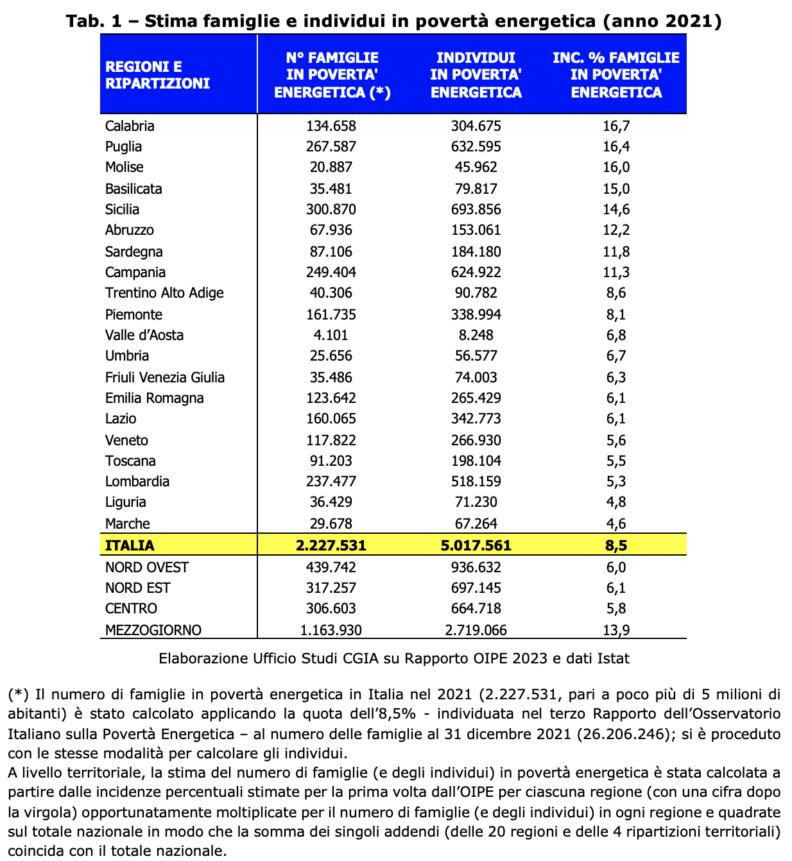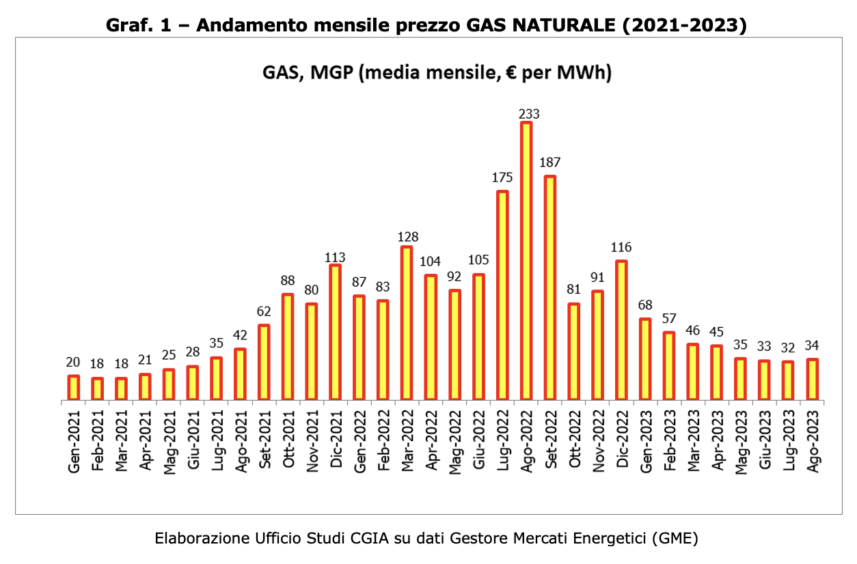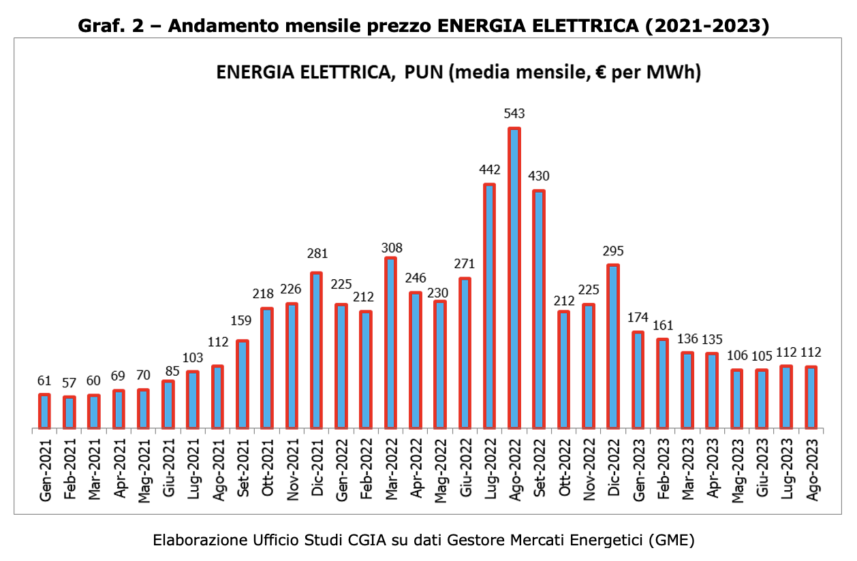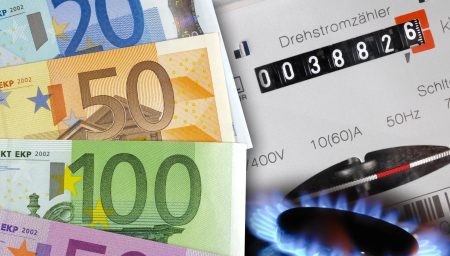There are 2,2 million Italian families in energy poverty (PE). We are talking about 5 million people who in 2021 lived in unhealthy homes, poorly heated in winter, poorly cooled in summer, with poor lighting levels and with very limited use of the main white appliances [refrigerator, freezer, washing machine, dishwasher, dryer, etc]. The families most at risk are made up of a large number of people, are in conditions of economic hardship and the homes in which they live are in a poor state of repair. At a territorial level, the most critical situation occurs in Calabria, where 16,7 percent of families, made up of 304.675 individuals, find themselves in PE conditions. This is followed by Puglia (16,4 percent), Molise (16 percent), Basilicata (15 percent) and Sicily (14,6 percent). The regions, however, least affected by this phenomenon are Lombardy (5,3 percent of total families), Liguria (4,8 percent) and, in particular, Marche (4,6 percent). The national average figure is 8,5 percent and is up 0,5 percent compared to 2020.

This is stated by the CGIA Research Office which processed the data taken from the 2023 OIPE Report[2]. These results, unfortunately, are of considerable concern, also because they are certainly undersized, as they refer to before the energy shock that erupted in our country at the beginning of 2022. The main professional conditions of the head of the family found in PE are, in general, three: unemployed, single pensioner and in many cases, underlines the CGIA, when he works it is self-employed. Finally, it should be underlined that the families most at risk of PE, especially in the South, are those who use gas as their main source of heating. Those who use other fuels (gas cylinders, pellets, diesel, wood, kerosene, etc.) have lower percentage risk values.
Compared to pre-Covid, today the cost of gas and electricity has more than doubled
Although household and business spending on electricity and gas bills has been decreasing for several months, the increase in energy costs compared to the pre-Covid period still remains very high. If the average price of natural gas in 2019 was 16 euros/MWh, in August this year it reached 34 euros/MWh (+112 percent). Electricity, however, in 2019 cost on average just over 52 euros/MWh, last month it reached 112 euros/MWh (+115 percent). After the peaks reached in August 2022, gas and electricity prices have started to fall again. Today they are practically in line with those we had between July and August 2021.


The self-employed pay double bill increases
Energy costs continue to worry many families, also in light of the deadlines expected by the end of this month. In fact, if the aid put in place by the Meloni government with the 2023 budget law is not extended, from next October we will have a sharp increase in bills and the ones who will pay the bill will above all be the families of self-employed workers. Remembering that around 70 percent of artisans and traders work alone, that is, they have neither employees nor family collaborators, many artisans, many small traders and as many VAT numbers have paid twice the surge in electricity and gas bills that has occurred in the last two years. The first as domestic users and the second as micro entrepreneurs to heat/cool and light their workshops and shops. Finally, we would like to point out that although the risk of poverty or social exclusion of families present in Italy has decreased in recent years, even in 2022 those with a main income from self-employment had a poverty risk equal to 19,9 percent of the total, against 17,2 percent of families with their main source of income from employment. Unfortunately, even after Covid, the energy crisis and the inflation boom, households in which the head of the family is a self-employed worker continue to have greater economic and social fragility than those of employed workers [Families that can mainly rely on pension income and/or public transfers, however, present the highest risk of poverty or social exclusion, equal to 34,2 percent. The latter data remained unchanged in both 2021 and 2022]. These bonuses, therefore, must be extended, at least until the end of next winter, to provide support to those who are still in financial difficulty. Unfortunately, the forecasts are not at all reassuring; according to Nomisma Energia, starting from next October bills could undergo an increase of between 7 and 10 percent.
Energy bonuses expire at the end of September
In the two-year period 2022-2023, the Draghi and Meloni governments introduced some measures to contain spending on electricity and gas bills for families and businesses of over 91 billion euros. The current executive has announced that the measures still in force and set to expire on September 30th will be extended at next Monday's Council of Ministers. They are:
- VAT reduced to 5 percent on the supply of methane gas for civil and industrial uses (the ordinary rate is 10 percent). The VAT reduction also applies to district heating and energy produced with methane gas;
- elimination of system charges on gas bills (system charges on electricity bills have instead been reintroduced from 1 April 2023);
- strengthening of electricity and gas bonuses for families in conditions of economic and physical hardship: the ordinary check will continue to be supported by an extraordinary bonus which will increase the amount of the discount.
It should also be remembered that, however, the measure that provided for tax credits of 40 and 45 percent for companies that had recorded price increases in their bills of more than 30 percent compared to 2019 expired last June.
